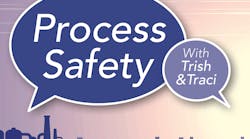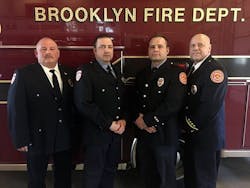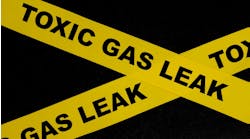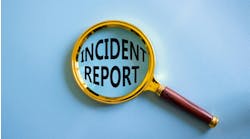Podcast: Understand The Importance Of Partnering With First Responders
When disaster strikes, first responders already have a tough job ahead of them. Don’t put them in further danger by failing to effectively communicate what your facility does and what hazardous substances are stored there.
In this episode, Trish & Traci speak with Fire Inspector Bryan Suesse about the dangers first responders face and how chemical-processing facilities can mitigate risks and help save lives.
Transcript
Traci: Welcome to this edition of "Process Safety With Trish & Traci," the podcast that aims to share insights from past incidents to help avoid future events. I'm Traci Purdum, senior digital editor with Chemical Processing. And as always, I'm joined by Trish Kerin, the Director of the IChemE Safety Centre. Hey, Trish.
No worries! Subscribe and listen whenever, wherever.
Trish: Hey, Traci. How are you doing today?
Traci: I'm doing all right, not too bad. Looking forward to our conversation today. We have a guest with us, a special guest, a first responder based in Cleveland, Ohio, Brooklyn Fire Department Local 1145 President Bryan Suesse. He is a firefighter paramedic and also serves as a fire inspector and a hazardous-materials expert. Bryan, thanks for taking the time out of your busy day to chat with us today.
Bryan: Thanks, Traci. Thanks for having me.
Traci: For today's topic, you might have guessed, we are going to talk about the importance of making sure your facilities are up to date with the proper information to not only help your own team avoid disasters but in the event of an incident, making sure that the first responders aren't caught unaware of what lurks behind the gates.
Trish, you and I have discussed several catastrophic incidents that claimed the life of the first responders. Can you talk briefly about some of those events and what chain of errors led to the loss of life?
Trish: Yes, certainly. So, I think the one that most recently springs to mind for everybody is West Texas, where we saw the loss of 15 lives during that particular incident. And I believe most of those were the volunteer firefighters at the time. And I think one of the biggest issues there was that they didn't know what they were going in to fight. They thought they were just fighting a bonfire, effectively. They did not know there was ammonium nitrate in that building. And I think even if they had have known that, I'm not really sure that they had the right information to know that the ammonium nitrate could then detonate. So, they were very much caught unawares and, as I said, it tragically led to their death.
That's not the only incident where that has occurred there. There have been a number of incidents where lives have been lost. Another one that did involve emergency responders and, thankfully, there was no fatality, but the internal firefighting team in the Richmond, California, fire where the team was actually engulfed when the leak caught fire. And the CSB have got a great video on that one as well as West Texas, talking about some of the response related issues. The issue is if the emergency responders don't adequately understand what they're facing, they can't fight it adequately and they also can't make sure they protect themselves.
And let's be very frank about this, they're made to protect themselves as the highest priority first. Because if they don't, then they can't be there to help anybody else. So, if you have a fire brigade turn up because you've got an incident, and I certainly know that this happens in Australia when the fire brigade turn up to an industrial fire, you actually have to spend a few minutes convincing them to come onsite. They don't come riding in on their big white horse. They need to protect themselves as a matter of urgency and most important, because otherwise, they can't help you.
So, you have to convince them that it's the right thing for them to do to respond, and how to respond and give them all the information as to what is on your site, what are the chemicals you have. And if you're not onsite, then that information needs to be available to them somehow so that they understand not to put water on a water sensitive chemical, for example. They're really fundamental chemistry and physics-related issues that if we don't give them the right information, they potentially are put in danger and they die. And that serves nobody at all, least their families.
Traci: Absolutely. And Bryan, what comes to mind when you get a call from a chemical facility or an industrial park that houses hazardous substances?
Bryan: The first thing that comes to mind is we have a good deal of industry in the city of Brooklyn. It's only four square miles but we have a lot of different types of companies and new companies coming in all the time. And one that comes to mind that's most recent is we have a company with a lot of magnesium. And if you're not familiar with magnesium, you can't put water on magnesium. As soon as you do that, it sparks a tremendous amount of fire. And, luckily, our guys were trained enough and the workers in the plant were trained enough to know better not to put water.
So, that actually saved a pretty big disaster from happening for them using the proper extinguishing devices. I feel like, as an inspector, a lot of companies are not proactive in reviewing what's in their plant. We basically, and especially me being an inspector, have to go in, we have to dig. We have to get MSDS sheets. We have to find out what's going on. We have to find out the chemicals.
There's a lot of companies, I'm not going to throw a specific one under the bus, but it feels like a couple of them almost hide certain chemicals that they have, for whatever reason. They know it's dangerous, but we just want to know where it is, how much you have of it. And I feel like we just have to constantly do that digging to find out what's in a lot of these companies.
Traci: Now, is that after the fact or if you were called to the facility, are they forthright then? Or is this something that you think that they're just trying to... You know, I'm trying to understand why they're trying to hide those facts.
Edward Kriausky, left, Edward Coyne, Bryan Suesse and James Mochan received the "Star of Life" Award from the Ohio Public Safety Division of Emergency Medical Services. Source: Brooklyn Fire Department
Bryan: I don't think there's specifically...maybe I use the wrong terms, I don't think sometimes they're specifically trying to hide the chemical. I don't know if being in business, your first thought is, how can I educate the firefighters and first responders? I think a lot of their thought process is based on business and getting business taken care of, and doing what's good for them and it's kind of like an afterthought. So, we just basically have to go in there and find out what type of chemicals they have, find out how much of the chemical they have. Do they have the proper extinguishing agents? Are their employees trained to know what to do?
And I feel like it's a constant battle. Like almost every shift, I'm going to certain companies and I'm finding out what's going on. We have a ginormous building that houses probably seven or eight different businesses and they're all industry businesses. And we constantly have to go in there. I feel like they're ever-changing. So, we constantly have to go in there and find out what kind of chemicals they have. And I feel like it's an uphill battle sometimes.
Traci: Is this preemptive? Are you going in preemptively or when incidents happen you're asking what is in the building?
Bryan: Me personally, I'm proactive, so...
Traci: Okay. So, you're wanting to understand what they have so that you can disseminate that information to the first responders in the area so that they know what they're going in on? Is that how you're working at?
Bryan: Yes, that's what I'm trying to work towards because I just feel, like I said, I hate to reiterate myself, but I feel like the company is not real proactive in that aspect. So, we have to be... Like I said, I don't think they're necessarily trying to hide anything. Sometimes I feel like they're not coming to us and saying, "Hey, we've got this new chemical," or we've got this new...or we carry this much more now. Because I mean, carrying, let's just say they carry sulfuric acid or something, carrying 100 gallons is not a big deal unless they have like 10,000 gallons. That can be a big deal. So, we want to know amounts and what does it mix with.
I'm not a chemist. So, anything that they do or whatever, a lot of times I'll have to do a little bit of research on it and see what it mixes with and see what's good and what's not good. We have a lot of resources but, you know, a chemical to them that may not be a big deal may be a big deal to us.
Traci: Now, Trish, you know, what can companies do to help ensure that first responders have all the information they need? You know, how can they work better, I guess?
Trish: So, one of the things that I certainly am aware of that I know we need to do in Australia, and I'd be interested in Bryan's thoughts as to whether this is a legal requirement within the U.S., and then if it's not, if it could even work, is businesses are required by law to establish a manifest list and that has to contain all of their safety data sheets in it. It has to contain information about the volume of each substance they have, where it is located on the facility, on a plane of their facility, as well as all of its hazardous chemical coding. So, you know, whether it's the UN number or whatever different coding system you use, because I know the U.S. one is slightly different to the one that we use in Australia. I know these are all based on the same United Nations system.
So, you know, we have to have that documentation and, by law, it must be kept up to date. And our workplace safety inspectors can come and inspect that at any time and prosecute you if you don't keep that up to date. So, we have that, first of all, and that needs to be made available to the fire brigade as they arrive. If you are a facility that has certain quantities of substances, so if you're a very small facility, you won't get caught up in this. But the next size up of facility, legally, we are also required to have emergency exercises with our local fire brigade.
So, we actually have to, at least every five years, bring them onsite and run through a response exercise with them. And you know, we'll simulate whatever it is we might want to, you know...this chemical is going to be leaking on this particular exercise, and run through to make sure that not only the staff on the facility understand what's going on and know what to do, but we've given the right information to the firefighters to be able to respond as well. So, we certainly have that structure in place, and for your large industries, that is absolutely mandatory to do it on a frequency basis. It's less frequent for some of the smaller ones. And then the very small companies don't have to do it.
But we're starting to see some interest in tightening some of our regulations because we had a situation in Victoria where I lived a few years ago, where there was a company that was storing waste, chemical waste. They were providing a service, as they said, to industry to dispose of chemical waste appropriately. Turns out, they actually weren't doing that. They were just storing it, mixing it, dumping it in warehouses. And there was an incident, there was two incidences actually, of those warehouses catching fire.
And it created enormous toxic issues, injured and made ill firefighters, which is quite a significant thing, and left an enormous environmental impact to clean up. So, I think in Victoria, at least, we're going to start to see some more tightening around some of those laws. And there were definitely prosecutions for the individual who owned the company because he was breaching many, many of our laws. So, yeah, do you actually have the manifest, the requirement to have or produce manifest available onsite for the fire brigade at any point, Bryan?
Bryan: Yes. They report all their chemicals to the state of Ohio. We'll receive a letter from the state of Ohio about a company in our district, and it'll state the chemicals and what they have. But what I found is it's very inconsistent. I will get one for one business, maybe not one from another, or it'll be a couple years before I get another one from the same business.
I haven't really dug into that a whole lot about what the legality is with that, but I know they're supposed to... You know, the only thing I know really they're supposed to do is just have the MSDS sheets available for us if we require them. And we can have them on hand, it's fine, but it would be nice to get those on a yearly basis just sent in from the state of Ohio, like I've gotten a few times, and just have those. We put them on file or we put them in our database. We have a new database that when we show up to a commercial building, it'll tell us what the manufacturer is, what they do, what chemicals are in there, and stuff like that. So, we've been working on that database to get that updated, but it's taking quite a bit of time.
Trish: It sounds like a similar system. It's possibly around the application of it that could be challenging.
Bryan: Yeah, yeah. The new program that we're supposed to have is going to be nice once we get it set up. But switching from an old program to a new program and updating everything takes a lot of time. It takes a lot of time, a lot of effort, contact information. It's amazing how many times you go into a business and the contact information is different all the time. This person left. This person is no longer there. You call a number and that number is no longer good. So, it seems, like I said before, like an uphill battle sometimes keeping things up to date and keeping the information up to date.
Traci: You know, Bryan, Trish had mentioned something about in Australia they partner with the local fire brigades. Is that something that happens here? I know you can only speak to your portion of Ohio. But do you ever go into companies and help them do safety training days? Or did they ask for that type of thing?
Bryan: Very rarely. There's only one company I can think of that's actually asked us to help them, and it was Arrow International. And they make paper products, like envelopes, and they make all kinds of things. They have their hands in the little bit of everything. So, they do have some chemicals there and some stuff. But they're very proactive with their employees in setting up an emergency response system as far as getting everybody out of the building, and what to do in different scenarios. So, they've been the only one that I can really think offhand that's been actually proactive.
But then like, again, it's a new contact, new information, new chemicals. And they switch this around, and I have to come in and look at something different. And if they're not up to date on it and, say, you miss a little bit or they change names and change ownership and change what they're doing, and if we don't know about it then we get a fire there, we walk into something new. And that's just one of the issues that we constantly have.
Traci: And you mentioned, you're not a chemist. You're not well-versed in these types of what happens behind the doors. But how do you train for emergencies in these types of environments? Obviously, it's a different attack than if you were going into a house fire.
Bryan: Right. Well, like Trish was saying too before, you have to know some basics in what to put water on and what not to put water on. And when you have a large fire that's blooming multiple colors of smoke out of the building, and you don't know what's mixing with what, we just do a defensive attack at that point. Nobody's going into the building. We make sure everyone's out of the building first. But none of the firefighters are then going into the building at that point because, I mean, it's just become a bigger disaster if you start sending people in. We have pretty good protective gear but against certain chemicals, who knows? When certain chemicals mix or how that happens, who knows what that could do to your gear or your face mask or anything you have that might be exposed?
Traci: What would be the ultimate thing coming into that sort of situation? Trish had mentioned about when they come on scene, convincing them that they have everything they need to know before they walk in. What...as a first responder, would you want somebody to meet you at the gate and say, "This, this, and this are on our campus?" Are there things that would make your job easier? I guess, it's what I'm getting at.
Bryan: Yeah. Usually, the manager of the plant has a pretty good idea of what those chemicals do. So, if that person met us, or someone who knows those chemicals very well met us, and told us exactly maybe where the fire is, exactly what's mixing, exactly what's in there, what it can and can't do, that is extremely helpful to us. We know what we're walking into. We know what we're getting ourselves into. We feel better about putting people either around the building or in the building if we have to. So, that would be extremely helpful.
Traci: And Trish, the chemical industry unavoidably deals with flammable and explosive substances. What do you think first responders should understand about the industry to better train for incidents? Are there some default things that they should just know or are there training materials that they can read up on?
Trish: So, there is a whole lot of information that you'll find the fire brigades' already using to do some of their basic training. So, I mentioned some of the Hazchem codes. They describe precisely how to tackle certain chemicals. So, each chemical has its own code and that describes, you know, is it a water-reactive substance or not? Do you need to use foam on it? Do you need to evacuate? Do you need to be using breathing apparatus? All these sorts of things are contained in a code. And obviously, our fire brigade are very fluent in understanding that information so that they can look at the code and know what that means and what they need to do to respond.
So, the diamond-shaped thing that's on trucks in the U.S., we laid the code out slightly differently in Australia. But I've seen that the diamond-shaped things that have different segments in them. They tell someone a lot of information about what the substance is. One of the challenges to industry, though, is the industry needs to also provide the right information back into the fire responders because what industry does with the chemicals while they're onsite, if they're in-process, could make a difference as well. It could be transformed into something slightly different. It could be under different pressure or under elevated temperature, or even under decreased temperature, and fire may have some impact on that because of the chemistry.
Now, we can't expect all the fire brigade to understand the detailed chemistry of what's going on in a company because the company is doing it. The company must provide that information back so that the firefighters can actually respond with what they need to respond to. And I think that's where we often do see that gap. So, a fire brigade is very highly trained and very knowledgeable on a whole range of different things in terms of dealing with fire on certain substances. They learn all of that, and they are the experts on that. But the industry is going to be the experts on what's going on with that chemical in our facility at that point in time.
Both parties need to come together and share that information. And I think that would be one of the greatest things we could get happening if we got better communication from the company into the emergency responders to know what's actually going on on the site.
Bryan: I agree.
Traci: Absolutely.
Bryan: We do carry one book. It's an MSDS book. It's an orange book. And as far as I know, it pretty much has every chemical known to man, and it shows the placard symbol, if it's on a tanker, and what that tanker is holding. And you can also look up the chemical name. If someone comes out of a building and says, you know, "This is the chemical that's on fire," we can look up that chemical in the book real quick to see what are the dos and don'ts with that chemical. But as nice as that may sound, it is much easier if someone's onsite and has the ready availability of knowledge to tell us what that chemical is all about.
Traci: Absolutely. And Bryan, as a fire inspector, are there "aha" moments in investigations that point to where things went horribly wrong? And when you find those, if there are those moments, do you share those findings with the local businesses so they can better prepare next time?
Bryan: Yes. So, every year, I do annual inspections on all our businesses in the city. I tell them what they need fixed, what needs to be put away, what can't be put out, how things need to be stored. For instance, paint and paint thinners and acetylene tanks and oxygen tanks have to be stored a certain way. So, I go through each business with them and, you know, exit signs. They have to be...emergency lighting. We go through the whole business when we do the dos and don'ts and see what needs to be fixed.
And then I write them, either they're clear and good to go or I put violations down and they have a certain period of time to fix those violations. But most companies are good about doing that once the violation is brought to their attention.
Traci: And what would be your best advice for facilities? The facility itself serves as the first responder when an incident happens. They have to make the call. They have to start moving people. What is your best advice to help them along until you get on scene?
Bryan: Well, usually it's just get out of the building. So, as long as everyone knows how to evacuate the building, and knows where to get out. You know, if it's something small and you have people trained in using extinguishers, and that's what the chemical takes, great. I mean, use the extinguisher if someone's comfortable using it. If not, then we advise people to just get out of the building and call the fire department. And we will handle it from there.
Traci: Trish, is there anything you want to add? I know that we're talking about these companies need to be responsible corporate citizens and make sure that their local first responders understand everything. But I'm curious, do you have anything to add?
Trish: I think from my perspective, it really is just making sure that as a company operate, you've got the right information, and you share that information. So, you need to keep it up to date. And that means you need to have good management of the changing process in your organization, if you're changing the chemicals that you're storing or even the quantities of the chemicals you're storing. You need to understand what's going on and you need to then share that with the emergency responders. Remember, these people are there to help you. The last thing you want to be doing is putting them in danger because you failed to communicate something effectively to them. So, creating that two-way communication, inviting them in for a conversation, "Here's what we've got, here's how we use it, here's what's going on in our site," so that people like Bryan and his team have all the information available to them when they come onsite to help you.
This is really about getting communication better between the company and our emergency responders because we both need to work together on this.
Traci: Absolutely. And I so appreciate your time, Bryan and Trish. Again, you're champion of process safety for our listeners. Unfortunate events happen all over the world, and we will be here to discuss and learn from them. On behalf of Trish and our guest, Bryan Suesse, I'm Traci and this is "Process Safety With Trish & Traci."
Trish: Stay safe.
Check out all the episodes of Process Safety With Trish & Traci.
Want to be the first to know? Subscribe and listen to Process Safety With Trish & Traci on these platforms










